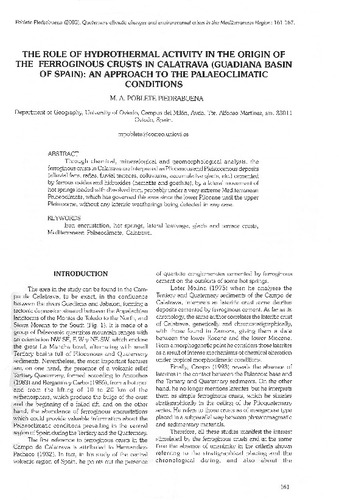The role of hydrothermal activity in the origin of the ferruginous crusts in Calatrava (Guadiana Basin of Spain): an approach to the paleoclimatic conditions
Autor(es) y otros:
Editor/Coord./Trad.:
Palabra(s) clave:
Iron encrustation
Hot springs
Lateral lessivage
Glacis and terrace crusts
Calatrava, Spain
Fecha de publicación:
Editorial:
Universidad de Alcalá
Citación:
Descripción física:
Resumen:
Through chemical, mineralogical and geomophorlogical analysis, the ferruginous crusts in Calatrava are interpreted as Pliocenous and Pleistocenous deposits (alluvial fans, fluvial terraces, colluviums, accumulative glacis, etc.) cemented by ferrous oxides and hidroxides (hematite and geothite), by a lateral movement of hot springs loaded with dissolved iron, probably under a very extreme mediterranean paleoclimate, which has governed this area since the lower Pliocene until the upper Pleistocene, without any lateritic weatherings being detected in any case.
Through chemical, mineralogical and geomophorlogical analysis, the ferruginous crusts in Calatrava are interpreted as Pliocenous and Pleistocenous deposits (alluvial fans, fluvial terraces, colluviums, accumulative glacis, etc.) cemented by ferrous oxides and hidroxides (hematite and geothite), by a lateral movement of hot springs loaded with dissolved iron, probably under a very extreme mediterranean paleoclimate, which has governed this area since the lower Pliocene until the upper Pleistocene, without any lateritic weatherings being detected in any case.
ISBN:
Colecciones
- Capítulos de libros [6535]
- Geografía [380]
Ficheros en el ítem




